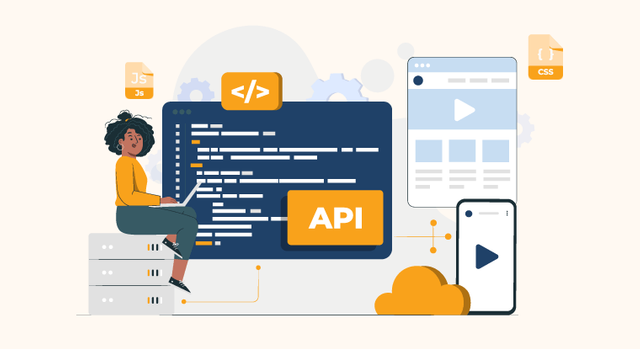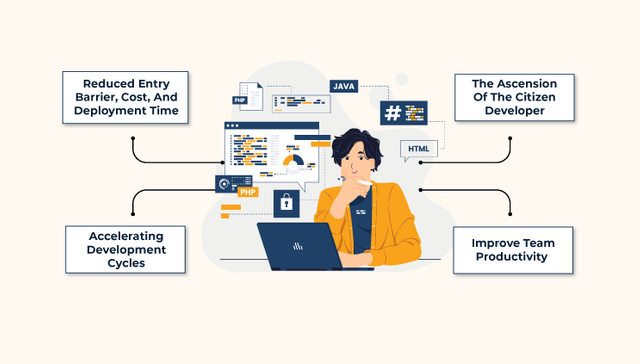What started the low code revolution?
Today's businesses must act fast or fall behind. Allowing non-IT professionals to design apps is one way companies have become more nimble. Low-code Revolution design allows this.
Low Code Revolution?
We must first define these phrases before examining the low code no code trend.
No-code platforms do just that. No-code platforms make software development as easy as Word or PowerPoint for non-technologists. Business users can drive initiatives without engineering staff.
A low-code developer platform (LCDP) provides rapid application creation, one-step deployment, execution, and maintenance using declarative, high-level programming abstractions such model-driven and metadata-based programming languages. Low-code solutions require coding. They use pre-written code components to speed up software development.
Low-code app development is transforming development (LCDP). These technologies could transform corporate software development if they deliver.
Given present technology, these solutions are welcomed. IT leaders are struggling with application delivery. Developer shortages and skill-set issues are limiting business automation. Low-code platform suppliers have expanded their efforts. They are simplifying commercial app delivery.
How Has the Movement Changed Over Time?
Low-code platforms like Fortran and COBOL were the first high-level programming languages. Fortran and COBOL need a lot of code, hence most programmers nowadays don't consider them low-code. In the 1950s, developers saw these languages as low-code solutions. Low-code programming advanced with Apple's 1987 HyperCard release. Programmers could design complex applications without writing code using HyperCard. They allowed graphical menus to build interfaces and functionality. HyperCard had a script for code-level control, although it was optional. Apple discontinued HyperCard in 1998, despite its popularity. Developers rarely recall the platform. Development platform makers can revive low-code and no-code due to this memory lapse. Today's low-code and no-code solutions resemble HyperCard. Renaming them helps marketers convince developers they're unique. LCNC now spans numerous sectors. Examples:
Education
Low-code power apps can be used to create programmes that analyse learning results, especially in diverse educational settings like different class sizes or online vs. in-person classrooms. It may also be utilised to connect digital platforms like enrollment and learning management. Finally, it can develop contact-tracing apps and websites. Today, most teaching is online, making these apps useful.
Finance
Low-code application builders can help financial institutions build customer-facing apps that integrate with back-end systems and work across platforms. These apps can check account balances and more. In a world when most takes are done on phones, such a platform is useful.
Healthcare
Like financial organisations, healthcare providers can use low-code no-code app development to create apps that communicate with back-end systems and allow patients to input data like symptoms. Modifying LCNC building components can also accomplish HIPAA compliance. Again, it meets patients' information needs.
What Can You Achieve With Low-Code?
Reduced Entry Barrier, Cost, And Deployment Time
The entrance hurdle, costs, and time to deploy new apps are reduced through low-code development. The entire development process no longer requires expert coders. Instead, experts in a field with little coding knowledge can be used. For instance, doctors and nurses could help write and implement a process in place of a programmer without any medical expertise, more completely addressing the issue.
The quickening of development cycles
By reducing development timelines, low-code app development lowers the entrance hurdle for new concepts. It is possible to create fully functional and aesthetically pleasing products in a matter of minutes as opposed to weeks. That alters the landscape for all industries.
Increasing Influence Of Citizen Developers
The majority of IT departments simply cannot meet the rising demand for apps and software in today's market. Citizen developers are amateurs who produce commercial programmes using modern technologies that have been authorised by corporate IT. With less code and a simpler development process, citizen developers may quickly build desperately needed apps. This modular approach shortens the development phase, accelerating time-to-value.
Summing It Up
Low code no code app development can be used in the next years to create new apps for data collection and collaboration that meet business and team needs. Development teams may include non-IT workers to solve business problems. These advancements will likely assist firms, especially smaller ones that cannot always afford developers to realise their ambitions. As the operations/IT gap narrows, organisations may be able to implement new strategies faster and without the IT constraints that have slowed growth.
Thus, 500apps' low-code platform is advantageous. This platform's intuitive interface speeds up app design, creation, and publishing. Create and save your applications on the cloud for faster and more comprehensive access.
AppUp speeds up app development from concept to launch by letting multiple people work on it. To give several apps the same look and feel, reuse project components.
Visit 500apps to use these fascinating capabilities to easily create apps and compete with other firms.

